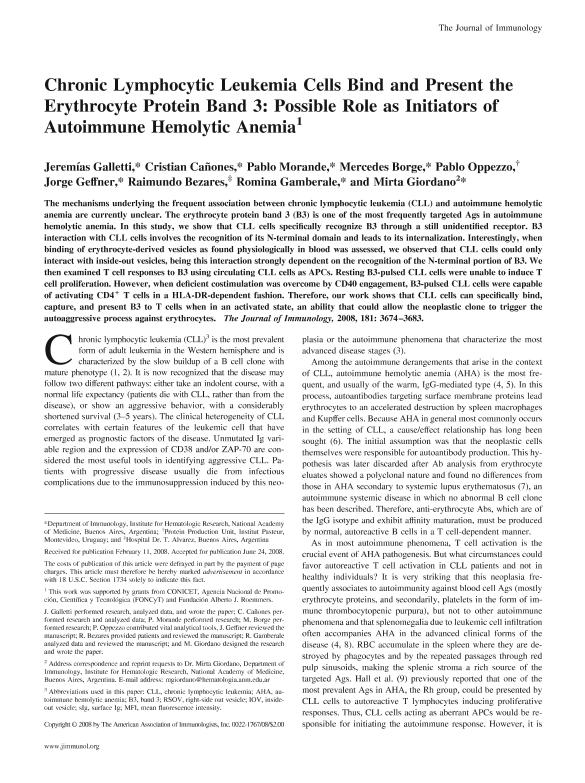Artículo
Chronic lymphocytic leukemia cells bind and present the erythrocyte protein band 3: Possible role as initiators of autoimmune hemolytic anemia
Galletti, Jeremías Gastón ; Cañones, Cristian; Morande, Pablo Elías
; Cañones, Cristian; Morande, Pablo Elías ; Borge, Mercedes
; Borge, Mercedes ; Oppezzo, Pablo; Geffner, Jorge Raúl
; Oppezzo, Pablo; Geffner, Jorge Raúl ; Bezares, Raimundo F.; Gamberale, Romina
; Bezares, Raimundo F.; Gamberale, Romina ; Giordano, Mirta Nilda
; Giordano, Mirta Nilda
 ; Cañones, Cristian; Morande, Pablo Elías
; Cañones, Cristian; Morande, Pablo Elías ; Borge, Mercedes
; Borge, Mercedes ; Oppezzo, Pablo; Geffner, Jorge Raúl
; Oppezzo, Pablo; Geffner, Jorge Raúl ; Bezares, Raimundo F.; Gamberale, Romina
; Bezares, Raimundo F.; Gamberale, Romina ; Giordano, Mirta Nilda
; Giordano, Mirta Nilda
Fecha de publicación:
09/2008
Editorial:
American Association of Immunologists
Revista:
Journal of Immunology
ISSN:
0022-1767
Idioma:
Inglés
Tipo de recurso:
Artículo publicado
Clasificación temática:
Resumen
The mechanisms underlying the frequent association between chronic lymphocytic leukemia (CLL) and autoimmune hemolytic anemia are currently unclear. The erythrocyte protein band 3 (B3) is one of the most frequently targeted Ags in autoimmune hemolytic anemia. In this study, we show that CLL cells specifically recognize B3 through a still unidentified receptor. B3 interaction with CLL cells involves the recognition of its N-terminal domain and leads to its internalization. Interestingly, when binding of erythrocyte-derived vesicles as found physiologically in blood was assessed, we observed that CLL cells could only interact with inside-out vesicles, being this interaction strongly dependent on the recognition of the N-terminal portion of B3. We then examined T cell responses to B3 using circulating CLL cells as APCs. Resting B3-pulsed CLL cells were unable to induce T cell proliferation. However, when deficient costimulation was overcome by CD40 engagement, B3-pulsed CLL cells were capable of activating CD4+ T cells in a HLA-DR-dependent fashion. Therefore, our work shows that CLL cells can specifically bind, capture, and present B3 to T cells when in an activated state, an ability that could allow the neoplastic clone to trigger the autoaggressive process against erythrocytes. Copyright © 2008 by The American Association of Immunologists, Inc.
Archivos asociados
Licencia
Identificadores
Colecciones
Articulos(IMEX)
Articulos de INST.DE MEDICINA EXPERIMENTAL
Articulos de INST.DE MEDICINA EXPERIMENTAL
Citación
Galletti, Jeremías Gastón; Cañones, Cristian; Morande, Pablo Elías; Borge, Mercedes; Oppezzo, Pablo; et al.; Chronic lymphocytic leukemia cells bind and present the erythrocyte protein band 3: Possible role as initiators of autoimmune hemolytic anemia; American Association of Immunologists; Journal of Immunology; 181; 5; 9-2008; 3674-3683
Compartir
Altmétricas



